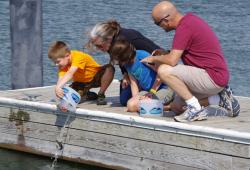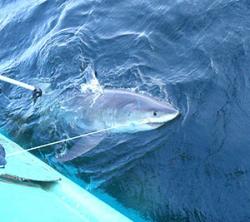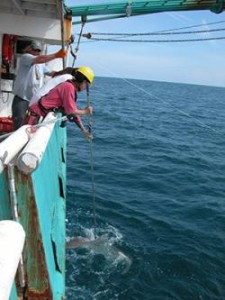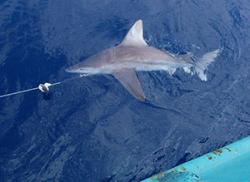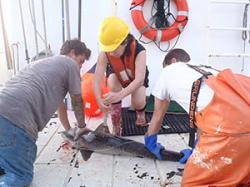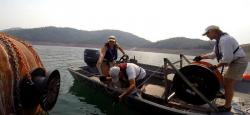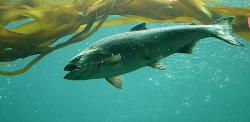Yep, You’ve Probably Got Snakes Around
EDITOR’S NOTE: Today’s feature from David Rainer of the Alabama Department of Conservation and Natural Resources points out the fact that healthy land means you have all sorts of wildlife on it- including….snakes.
from The Fishing Wire
Like humans this time of year, just about all God’s critters are looking for some shade, even those that give a good many people the shivers.
Despite being cold-blooded animals, snakes don’t like to get too hot in the summertime, and you may find a variety of reptiles seeking shelter from the hot summer sun.
A buddy of mine was concerned about finding a snake, which may or may not have been a cottonmouth, near his house recently.
Roger Clay, Non-Game Biologist with the Alabama Wildlife and Freshwater Fisheries Division (WFF), said if landowners and homeowners aren’t seeing a snake every once in a while, then something isn’t right.
“A lot of people always try to attribute seeing snakes this time of year to some kind of weather phenomenon,” Clay said. “It’s so hot. It’s so wet. It’s so dry. Some people say they haven’t seen a snake in X number of years, but there’s got to be snakes around. By some coincidence they see a couple in a short amount of time. Because they hadn’t seen any in a long time, they think they are suddenly overrun with snakes. But they’re really not.
“If you have a healthy environment, you’re going to have snakes. That’s the way it is. If you have a field next to you and they’re doing construction work or something, they may run a few snakes onto your property. That might be the phenomenon that accounts for you seeing a couple of snakes.”
Clay said if you live near water, then you’ll likely encounter a few snakes and other critters that live in and around the water or are just coming by to get a drink.
“Some people still don’t realize that any snake that lives around water is not a cottonmouth,” he said. “There are many more snakes that live in and amongst the water other than a cottonmouth.”
Clay said it’s sometimes hard to convince folks there are more than two kinds of snakes, what they call “water moccasins” and “ground rattlers.”
“For some people, every snake they see is a venomous snake, but in Alabama there are only six venomous snakes,” he said.
The venomous species include the pit vipers: cottonmouth, copperhead and the three rattlesnakes – eastern diamondback, timber and pygmy. The sixth venomous snake is the extremely rare coral snake.
“The coral snake is so rare you’re not going to find it in the front yard,” Clay said. “Coral snakes are usually limited to the southern half of the state, although we have records of them in the central part of state. A coral snake is so boldly colored people are not going to mistake it for one of the other snakes.”
There is an old saying about the coral snake that will give people an idea of what they’re looking for in identifying a coral snake.
It goes, “Red touch yellow, kill a fellow. Red touch black, friend to Jack.”
Clay said there are a couple of snakes that mimic the coral snake’s banding, but a coral snake has the only banding where yellow touches red.
“If somebody does see a coral snake, please let us know because they are so rare,” he said.
In terms of identifying the pit vipers, Clay said the dead giveaway is the elliptical pupil in the eye, although he realizes most people don’t want to get anywhere close enough to see an elliptical pupil.
“Some people say you can identify them with their triangular-shaped head,” he said. “That might be kinda true, but you can’t use that for positive identification. There are several non-venomous snakes that can change the shape of their heads to look triangular. It’s not doing them any good, but they want you to leave them alone.”
Clay said the appearance of a cottonmouth can vary depending on its age.
The juvenile cottonmouth (top) has distinct markings and a noticeable lightly tipped tail as it swims through the water. An adult of the species displays its “cottonmouth” (center) as a warning signal. The round pupil in the eye of a rat snake (bottom) indicates it is not a pit viper, which has an elliptical pupil similar to a cat’s eye.

Juvenile Cottonmouth
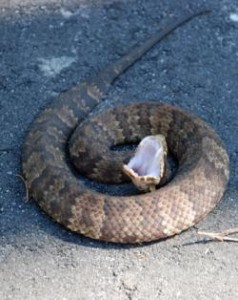
Adult Cottonmouth

Non-poisionous Snake
“When a cottonmouth is young, it has a pretty distinct pattern,” he said. “As it gets older, the pattern gets obscured. Secondly, when cottonmouths and copperheads are young, they’ll have a brightly colored tip on their tail. If you come across anything with a brightly colored tip on its tail, leave it alone.”
Obviously, most rattlers are identified by a diamond-shaped pattern and other markings as well as the rattlers. But other snakes also have distinctive patterns.
“If somebody sees a rat snake, they might think it has a pattern similar to a rattlesnake,” Clay said. “Rat snakes are definitely beneficial. It might be the best mouse and rat catcher out there.
“The question is whether you would rather have a rat snake out in your yard or a rat in your house?”
Clay said all snakes are beneficial in their own ways, especially the kingsnake, which regularly dines on several of the venomous species.
In fact, there was a video on Facebook of an eastern kingsnake consuming a rattlesnake. The video starts with the rattlesnake hopelessly snared in the kingsnake’s coils. The kingsnake then slowly swallows the rattlesnake head first. About 10 minutes later, the rattlers disappear down the kingsnake’s mouth.
“Kingsnakes are famous for eating other snakes, including venomous snakes,” Clay said. “Obviously, you don’t want to kill a beneficial kingsnake. The thing about a kingsnake is that its head is not going to look like a pit viper.”
Clay said sometimes people will mistake other reptiles for a rattlesnake because they hear some kind of rattling noise.
“A lot of snakes will vibrate their tails when they feel threatened,” he said. “If they’re in dry leaves, it may sound like a rattle. That’s just a defense mechanism.
“The good thing about snakes is they eat only small animals and other critters. They don’t eat fruits or vegetables. The small snakes are going to eat insects or small invertebrates. The larger snakes like the black racer, garter snake and rat snake will eat what they can catch, which is mice, rats and other snakes.”
Most snakes will seek an escape from the summer heat and will typically find shelter underground.
“Snakes don’t like it too cold or too hot,” Clay said. “You’re going to find them in shady areas in the summertime. If they get caught out in the sun for too long, they’ll get too hot and die. So they’ll be seeking shelter during the hot times of the day.”
If a snake is encountered, Clay recommends that you give the reptile a wide berth and leave it alone.
“A lot of people want to know if there is anything they can buy that will keep the snakes away,” Clay said. “The short answer is no. Snakes generally like hiding places, so keep your yard mowed low and keep it nice and tidy to eliminate hiding places. If you’ve got a pond nearby, keep the edges trimmed of tall grass.”
—David Rainer
Alabama Department of Conservation and Natural Resources

